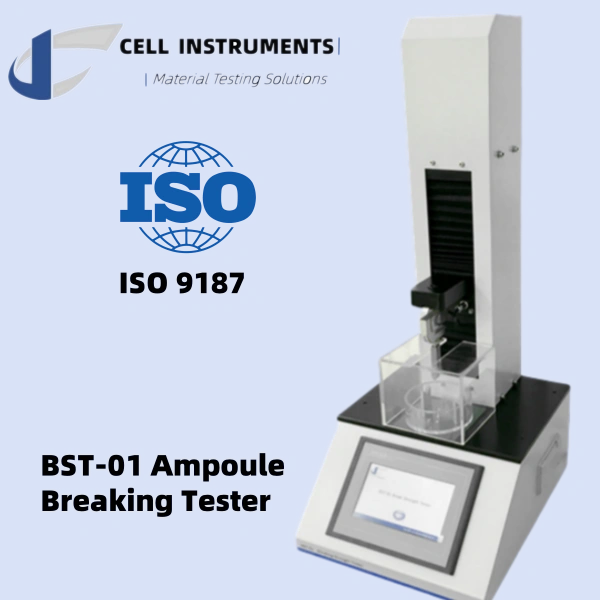Introduction to Sodium Chloride Ampoules

Sodium chloride ampoule is a widely used packaging format in the pharmaceutical industry, commonly serving injectable solutions for clinical and hospital use. These ampoules must meet strict safety and quality standards to ensure sterile conditions and break integrity. One of the essential performance indicators is the breaking force, which determines the ease and safety of ampoule opening during medical procedures.
This article outlines the standardized testing process for sodium chloride ampoules based on ISO 9187-1:2010, focusing on the practical use of a break force tester machine to ensure conformity, product safety, and operational efficiency. The information is particularly useful for quality control professionals, manufacturers, and validation engineers.
Importance of Breaking Force in Sodium Chloride Ampoule Testing
The breaking force of a sodium chloride ampoule refers to the force required to cleanly detach the ampoule head from its body at a designated breaking point. If the required force is too high or inconsistent, it can lead to user injury or ampoule shattering—both of which compromise sterility and safety. ISO 9187-1 outlines strict parameters to assess this property.
According to Clause 6 of ISO 9187-1, ampoules must be provided with a predetermined breaking point (e.g., ceramic ring or colored dot), and the force applied must follow a standardized method.
Key criteria include:
- Breaking force values must conform to Table 2 of ISO 9187-1
The angle of applied force must be 90° to the ampoule axis
Testing must be conducted under controlled temperature conditions (20°C ± 5°C)
Testing equipment must have calibrated load cells with 200 N capacity
Breaking Force Tester Machine for Sodium Chloride Ampoules
Why Use a Break Force Tester Machine?
To ensure precision and repeatability in testing sodium chloride ampoule strength, a break force tester machine is indispensable. Such machines simulate the conditions specified in ISO 9187-1 and ensure consistent application of force to the ampoule’s breaking point.
An ideal machine should include:
- Load cell capacity up to 200 N
Fixed test speed of 10 mm/min
Compatibility with ISO 7500-1 standards
Customized clamping mechanisms for glass ampoules
Recommended Equipment: BST-01 Ampoule Breaking Tester
Cell Instruments’ BST-01 Ampoule Breaking Tester is engineered for reliable and standardized breaking force tests. It supports
- Automatic data logging and force plotting
Adjustable sample holders for different ampoule types
Compliance with ISO 9187-1, ISO 9187-2, and ISO 7500-1
Clean break detection with visual and force-based feedback
This device is an excellent choice for manufacturers seeking regulatory compliance, GMP documentation, and automated reporting.
Best Practices for Testing Sodium Chloride Ampoule Strength
To execute a successful test:
- 1.Condition Samples: Store ampoules at 20°C ± 5°C for at least 24 hours.
- 2.Sample Size: Use statistical sampling in line with ISO 2859-1 (Inspection level S-4).
- 3.Machine Setup: Align the ampoule centrally on the machine’s metal bars.
- 4.Force Application: Apply tensile force gradually at 10 mm/min until breakage.
- 5.Record Data: Capture the maximum force at break and inspect the ampoule for clean separation.
Important: Positioning is critical. If the force is applied off-center, breaking force increases significantly, risking inaccurate results.
ISO 9187-1 and Breaking Force Requirements Summary
| Parameter | ISO 9187-1 Standard |
|---|---|
| Hydrolytic resistance | ISO 4802-1 / ISO 4802-2 – HC1 class |
| Annealing quality | ≤ 50 nm/mm optical retardation |
| Breaking force | As per ISO 9187-1 Table 2 |
| Testing angle | 90° to ampoule axis |
| Force application rate | 10 mm/min (± tolerance per ISO 7500-1) |
| Environmental condition | 20°C ± 5°C |
Why Sodium Chloride Ampoule Testing Matters
- Patient Safety: Prevents glass shard generation during opening.
- Operational Efficiency: Ensures consistent ampoule behavior in automated filling lines.
- Regulatory Compliance: Meets ISO and GMP documentation needs.
- Manufacturer Credibility: Demonstrates control over critical quality attributes.
Partner with Cell Instruments for Reliable Ampoule Testing
At Cell Instruments, we specialize in materials testing solutions for pharmaceutical packaging, including ampoules. Our BST-01 Ampoule Breaking Tester delivers repeatable, standard-compliant results for sodium chloride ampoule testing. We also offer customization and automation upgrades to fit your specific production line.
Conclusion
The sodium chloride ampoule plays a crucial role in injectable pharmaceutical products. Testing its mechanical integrity—particularly the breaking force—according to ISO 9187-1 ensures patient safety, usability, and regulatory compliance. By utilizing a high-performance break force tester machine like the BST-01, pharmaceutical manufacturers can uphold high-quality standards and streamline QC processes.
For reliable ampoule testing, trust Cell Instruments to deliver proven, precise, and compliant testing systems.